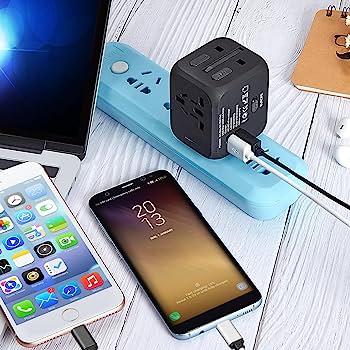As the world becomes more globalised and interconnected, it is now easier than ever to travel overseas. When travelling internationally, having the right travel adapter is essential to ensure that all your electronic devices can be safely plugged into different types of power outlets around the world. In this article, we take a look at different types of power adapters and explain their features, so you can have a better understanding of how they function and whether they suit your needs.
Table of Contents
Do you need a travel or power adapter?
Currently, there are varying socket standards and plugs found around the world. This is primarily due to the speeds with which various nations first set up their own domestic power grids. So, if a person is travelling away from their home country or region, then chances are they need a power or travel adapter.
This is because power outlets have different shapes in different parts of the world. As such, a power adapter for that particular country is needed to convert the shape of any home power plugs to the shape of the outlets in the region someone is travelling to. There are many types of plugs used across the world. For instance, a European plug will typically be a Type C, whereas a US plug type will be a Type A. In Asia, travellers will find that there is a wide range of plug types being used.
North America
The voltage in North America is 120 volts, with most electronic goods operating at around 110 volts. The plug type has two prongs with a third optional round pin. Other countries such as Brazil, Mexico, Japan, some parts of Egypt, Peru, and Thailand also use this type of power adapter.
UK and Ireland
The voltage for UK and Ireland is 230 volts, with most electronic goods operating between 220 to 240 volts. The UK and Ireland’s outlets require a unique 3 flat rectangular pronged plug type.
Europe
The region uses the same voltage as the UK and Ireland. However, the main difference is that Europe operates on a 2-round-prong outlet. Other countries such as Argentina, Morocco, Thailand, China, and Egypt also use the European 2-prong power outlet.
Adapter types
Once a traveller knows which type of plugs are used in the region they are visiting, they can start to narrow down their options. Depending on their specific requirements, they can opt for a single-region travel adapter, a multi-region plug, or a universal model.
Single-region travel adapters
Single-region travel adapters are the most simple and straightforward power adapters. An example would be a power adapter for the US. In addition to being used in their specific country, they can also be used in countries that all use the same sockets and voltages. While these power adapters are often the cheapest option, they are not as flexible as the other options, which may be a downside for frequent travellers.
Variations of this type of power adapter include the multi-way model (this features the ability to plug in several devices at the same time), and the option to pair single region travel adapters with a multi-socket extension lead. This helps with increased demand and multiple devices.
Multi-region travel adapters
If a traveller wants to opt for greater versatility, they can choose to purchase a multi-country or region plug adapter. For instance, this could be a Europe to Asia plug adapter. They are typically slightly larger or more complex compared to single-region travel adapters. This is because they are designed to accommodate several national standards of plug and socket arrangements at the same time.
The most common types of multi-region travel adapters handle a combination of European, Asia, UK and North American standards.
Universal travel adapters
Much as its name suggests, universal travel adapters are typically the most flexible option. This is because they are suitable for use in most countries around the world. That said, with increased flexibility comes an increase in size, which means they may not be as compact as multi-region or single-region travel adapters. This can make them tricky and less convenient to transport around. Another thing worth noting is that for less stable socket types (such as the US two-pin), the heavier weight means the adapter may be less securely attached to the socket.
Do travel adapters change the voltage?
It is important to note that the vast majority of travel adapters do not change voltage. However, many models are designed to work with a wide range of voltages and current ratings. As such, it is essential to check both the adapter and the device being used for compatibility with local voltages and currents before using it.
What features should buyers look for?
There are a few handy and additional features that may be included in a power adapter. This will depend on the model of the plug adapter. Some features that buyers can consider include:
- USB-C ports
- USB charging
- Wi-Fi functions
- Quick charge capabilities
- USB-PD
- Multiple voltage ratings
When comparing travel adapters, buyers should also think about their build quality, safety features, (such as surge protection) compactness, and user reviews. Buyers should also check if the adapter meets international safety standards and regulations.
Bottom line
Overall, selecting the right kind of adapter will depend on a person’s specific travel needs, destination, and devices they plan to use. Consider the above travel adapter options and pick the one that best suits your requirements for a seamless and hassle-free travel experience.

